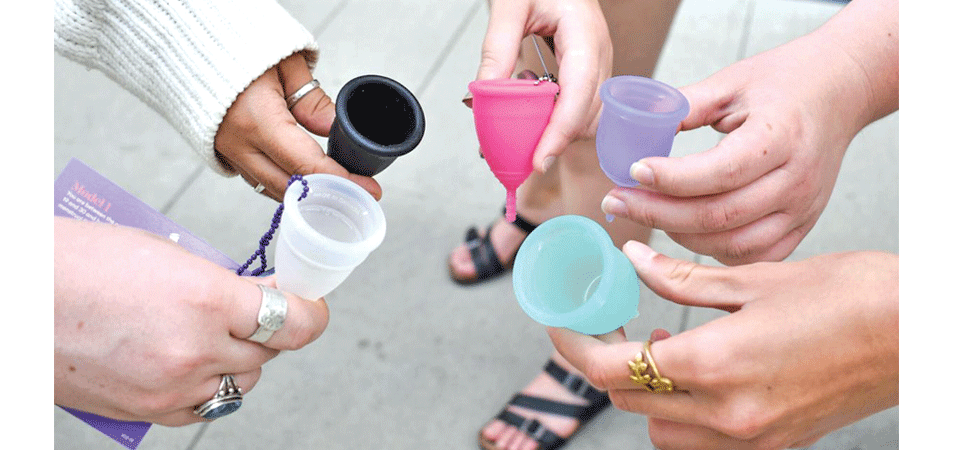Menstrual Cup: Step Towards Sustainability

Saya Mathema
The thought of the amount of plastic that we are depositing and its impact on our planet tortures me. The use of plastic today is so massive that we can in fact name today's era as the “era of plastic”. Every product we consume uses plastic and menstruating products is no exception.
Menstruation is a normal event but it is regarded as a stigma in our society. It is often linked to an unhygienic problem. The menstrual fluid is referred to as "impure" indicating it to be disgraceful and filthy. Girls are taught from a very young age to conceal it and hence they are often unable to discuss menstrual issues and often fail to choose the best menstrual products for themselves.
Menstrual Products
There is a wide range of menstrual products like sanitary pads, period pants, tampons, menstrual cups etc. The prominently used menstrual products in our context, however, is limited to disposable sanitary pads. Sanitary pads are made up of super absorbent various layers. A top layer made from polypropylene or polyethene, an absorbent layer made of cellulose, a super absorbent polymer or inner and a polyethene bottom layer. They absorb the menstrual fluid and are supposed to be changed every 4-6 hours. These pads are non-biodegradable and have a massive impact on the environment.
A single disposable pad is estimated to take 500-800 years to break down. On average, a woman menstruates for 40 years bleeding for say, 5 days each month, 2400 days in her entire lifespan. Let us assume she uses 4 pads per day, she will be disposing of 9600 pads in her entire lifespan. One can only imagine the environmental damage caused by pads disposed of by all the menstruating women.
Sustainable menstrual products are available and are gaining popularity in recent days. Menstrual cups are one of the sustainable feminine hygiene products. It is worn inside the body to collect menstrual fluid. It is made up of medical-grade silicone. These are available in different sizes. These can be worn for up to 12 hours before emptying, should be sanitized after each monthly use. A single cup can last for up to 10 years.
It is pocket friendly too. A cup may cost us around 800-1500 depending on the brand. Since a single menstrual cup lasts for 10 years, we will be spending only 800-2500 for ten years. On the other hand, we are spending around 200 every month on sanitary pads i.e. 2400 every year and 24000 in ten years. Hence, we will be saving around 21500 in ten years.
Many girls/women are still not aware of the burden disposable sanitary pads are putting on our planet. The reason why the majority of girls is unaware of the existence of sustainable menstrual products and prefers disposable sanitary pads is the variation in marketing and advertisements of the products.
The advertisements of sanitary pads promise girls liberty, convenience and hygiene. But are they meeting their promises? I reckon not. The harmful chemicals and fragrances present on pads have the potential to cause cervical and ovarian cancer. We also have to go through the same troubles: odour tension, rashes, cramps, infection, discomfort, wetness, and what not?
For that reason, I hated getting my period. Then, I switched to a menstrual cup and the way I viewed my period completely changed.
Menstrual cups, however, are not available everywhere until today. But there are different Instagram pages from where we can get our cup delivered. @peesafenepal, @putalinepal, @glow_getter_flow_cup are a few among others.
So what are we waiting for girls? Menstrual cups have it all. It is the sole solution for all our problems. There is no odour, no wetness and no discomfort. At some point, we may even forget if we are in a period. It is also free from harmful chemicals and fragrances. We shall finally be free of all the burdens. Besides, it is environment-friendly, pocket-friendly and convenient. I chose a menstrual cup and probably took the best decision for my life and our planet. It is now your turn to switch to menstrual cups and be the change. Cheers to one step towards comfort and sustainability.
( Mathema studies at Kathmandu University School of Management)
Recent News

Do not make expressions casting dout on election: EC
14 Apr, 2022
CM Bhatta says may New Year 2079 BS inspire positive thinking
14 Apr, 2022
Three new cases, 44 recoveries in 24 hours
14 Apr, 2022
689 climbers of 84 teams so far acquire permits for climbing various peaks this spring season
14 Apr, 2022
How the rising cost of living crisis is impacting Nepal
14 Apr, 2022
US military confirms an interstellar meteor collided with Earth
14 Apr, 2022
Valneva Covid vaccine approved for use in UK
14 Apr, 2022
Chair Prachanda highlights need of unity among Maoist, Communist forces
14 Apr, 2022
Ranbir Kapoor and Alia Bhatt: Bollywood toasts star couple on wedding
14 Apr, 2022
President Bhandari confers decorations (Photo Feature)
14 Apr, 2022










